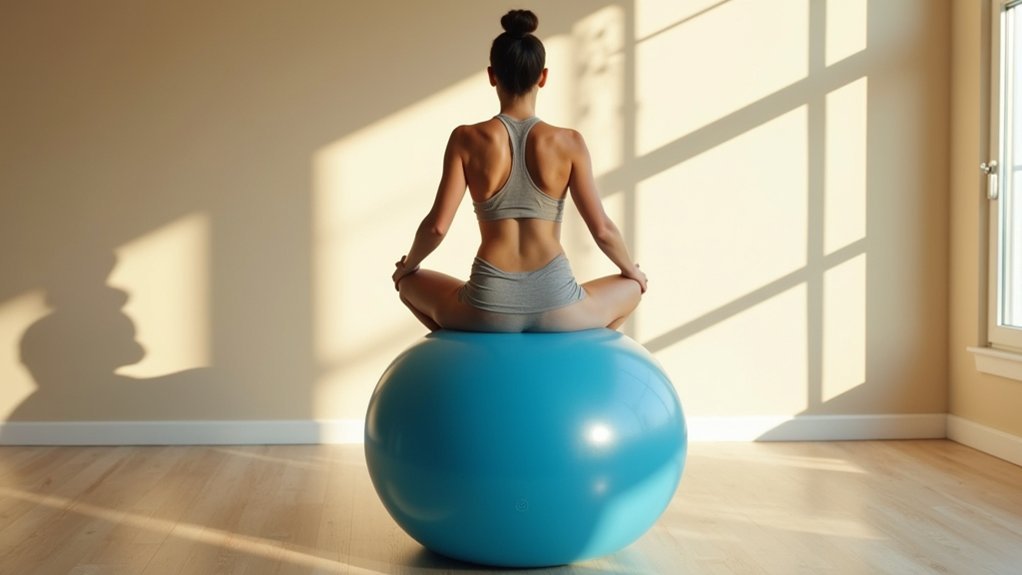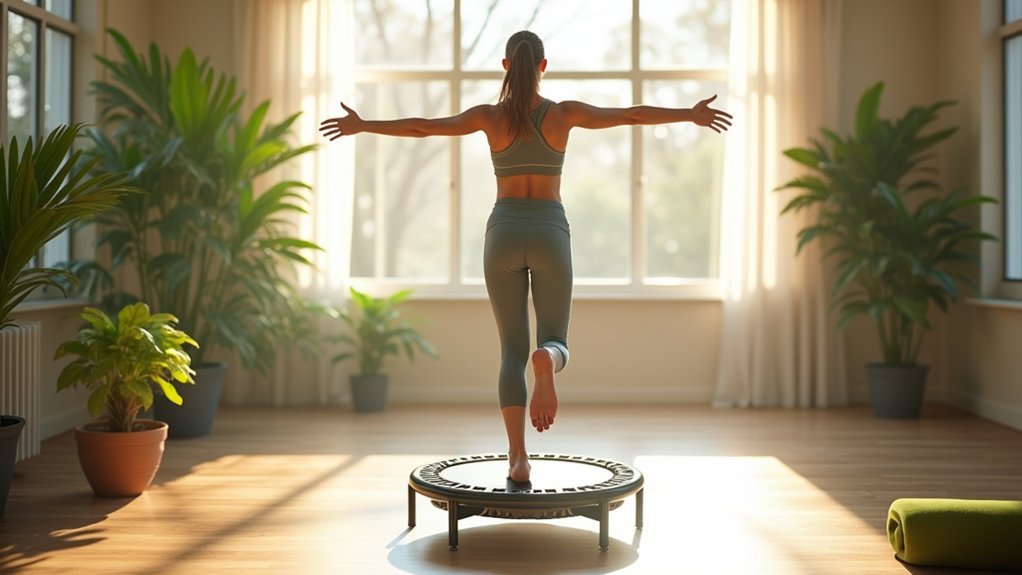Mini trampoline exercises can ease back pain through gentle spinal decompression. Try seated bouncing on a stability ball, gentle hip lifts while lying down, seated core activations, modified knee lifts, and side-to-side twists to improve mobility. Balance exercises like one-foot bounces and progressive jumping routines strengthen supporting muscles. Include calf-hamstring release bounces and cooldown stretches to complete your routine. These low-impact movements offer effective relief while building strength for long-term spine health.
Basic Gentle Bounce for Spinal Decompression

When your back feels compressed and tight, gentle bouncing offers a surprisingly effective solution for relief. This technique creates traction between vertebrae, allowing discs to rehydrate and nerves to decompress.
Gentle bouncing creates space between vertebrae, allowing your spine to decompress and find natural relief from tightness.
Start by lying with support under your lower back. Gently lift and lower your hips in slow, controlled movements lasting about 5 seconds per cycle. Aim for 10-15 repetitions, focusing on smooth, rhythmic motions rather than static stretching. Similar to the soup can exercise, this motion helps relieve pressure in the lumbar region.
You’ll feel the decompression effect as your spine lengthens, circulation improves, and tight muscles relax. Always move within your comfort zone, avoiding jerky movements that could strain your back.
If you experience sharp pain, stop immediately. Begin with short sessions, gradually increasing duration as your tolerance improves.
Core-Strengthening Health Bounce Variations
Strengthen your core while protecting your back with gentle torso twists that engage your obliques without straining spinal discs.
You’ll find these twists most effective when you maintain proper posture and twist from your midsection rather than your shoulders or lower back. A strong core provides stability for proper movement of your limbs, spine, and pelvis, making these exercises particularly beneficial.
For those needing lower impact options, seated core activations on the trampoline provide stability training while minimizing compression on vertebrae.
Gentle Torso Twists
Among the most effective bounce exercises for back health, gentle torso twists offer remarkable core-strengthening benefits while minimizing spinal stress. They target your abdominals and obliques while enhancing shoulder and arm strength without overloading your lower back.
When performing these twists, maintain a neutral spine and engage your core throughout the movement. These movements are excellent for strengthening the obliques, which are vital for proper spine support and maintaining good posture. Start with a smaller range of motion, gradually increasing as your flexibility improves. You’ll notice improved posture as these exercises elongate and strengthen muscles supporting spinal alignment.
For best results, warm up before twisting and avoid the movement if you have acute back pain or recent abdominal surgery.
Beyond core stability, you’ll enjoy additional benefits including improved digestion, reduced muscle tension, and enhanced circulation—all contributing to long-term back health and comfort.
Seated Core Activations
Seated core activations represent five essential bounce exercises that strengthen your back while providing stability and comfort.
They’re perfect if you struggle with traditional floor exercises or need modifications that protect your spine while building critical strength.
When performing these exercises, focus on controlled movements and proper breathing techniques to maximize effectiveness:
- Try seated leg raises by lifting your legs slowly while maintaining an engaged core.
- Practice the abdominal strengthener by holding your chair, drawing knees to chest, then extending legs at 45 degrees.
- Incorporate seated twists, moving your fists from side to side while following with your head.
- Add seated dead bug movements by raising your arms while maintaining perfect posture.
- Include knee lifts by slowly bringing knees toward your chest while holding the chair for support.
For optimal stability and safety during these exercises, ensure you lock chair wheels if your office chair has them, especially when performing movements that require leaning back.
Seated Bouncing for Severe Back Pain Recovery

For people with severe back pain, gentle rehabilitation options can make the difference between prolonged discomfort and gradual recovery.
When used properly, seated bouncing on a stability ball offers a low-impact way to engage core muscles and improve spinal mobility.
While bouncing, maintain proper posture and support your lumbar curve with a roll. Start with gentle movements, gradually increasing duration rather than intensity. The rhythmic motion can help interrupt pain cycles, reduce muscle guarding, and improve circulation to healing tissues. Taking regular breaks from prolonged sitting can significantly reduce pressure on your spinal discs.
Remember that stability ball bouncing isn’t a standalone treatment for severe back pain. Research hasn’t shown significant benefits when used alone.
Instead, incorporate it as one component of a thorough rehabilitation program that includes other exercises and pain management strategies, always being mindful of your body’s response.
Side-to-Side Twists for Lateral Spinal Mobility
Extend your arms outward while you rotate your upper body from side to side, creating gentle mobility through your thoracic spine.
You’ll want to maintain a slight engagement of your core muscles throughout the movement to protect your lower back. Tighten belly muscles when performing this movement, similar to the approach used in lower back flexibility exercises.
This controlled twisting motion helps improve lateral flexibility while reducing stiffness that often contributes to back discomfort.
Rotate With Arm Extensions
The gentle rotation of your spine combined with arm extensions creates one of the most effective exercises for improving lateral spinal mobility.
This movement primarily works your thoracic spine through rotation and lateral flexion, engaging your obliques, intercostals, and erector spinae muscles.
- Perform twists slowly and controlled, focusing on the lateral bending of your spine combined with rotation.
- Extend your arms outward to enhance thoracic rotation and engage shoulder muscles.
- Shift your hip to the opposite side to deepen the stretch and maximize spinal mobility.
- Maintain a neutral pelvis position to avoid compressing your lower back.
- Coordinate your movements with rhythmic breathing to optimize rib cage expansion.
This exercise reduces stiffness, improves posture, and relieves lower back pain by decreasing compensatory stress on your lumbar spine. Remember that the normal range for lumbar lateral flexion is between 40 to 60 degrees, so don’t force movements beyond your comfortable range.
Gentle Core Activation
Side-to-side twists deliver gentle yet powerful benefits for your spine while activating essential core muscles. These lateral movements engage your obliques and intercostal muscles, improving spinal mobility in the frontal plane.
When performing these twists, start from a neutral spine position and move with controlled, smooth motions. Keep your core engaged throughout to protect your spine and distribute load evenly. For optimal alignment, maintain shoulder blades contact with the ground as you would in a proper Spine Twist exercise. Breathe naturally—inhale when returning to center and exhale during each bend.
Regular practice enhances circulation to spinal discs, reduces muscle tension, and alleviates stiffness. You’ll also develop better neuromuscular control and proprioception around your spine.
For best results, focus on quality over intensity, especially if you’re managing back pain. This gentle activation helps maintain spinal health while preventing progression of postural issues.
Arm Circulation Movements While Rebounding

Blood-boosting arm movements transform your rebounding routine into a full-body circulation enhancer. While you bounce, these upper body movements activate your lymphatic system, flushing toxins and reducing inflammation that may contribute to back pain.
- Make large circular motions with both arms to stimulate blood flow to shoulder muscles.
- Alternate pushing arms forward and pulling back to engage core stabilizers.
- Raise arms slowly overhead during bounces to improve lymphatic drainage.
- Perform gentle twisting motions with extended arms to enhance muscle activation.
- Add light resistance with small weights or bands to increase cardiovascular benefits.
These movements improve joint mobility without straining your back, while simultaneously strengthening supporting muscles and promoting healing through enhanced circulation. The gentle bouncing motion of rebounding is significantly easier on your joints compared to exercises performed on hard surfaces.
You’ll experience reduced stiffness and improved respiratory function as your bounce sessions incorporate these purposeful arm patterns.
Modified Knee Lifts for Lower Back Support
When performed correctly on a rebounder, modified knee lifts create a powerful foundation for back health while maximizing lymphatic drainage. You’ll strengthen your core muscles—particularly the rectus abdominis and transverse abdominis—which directly support your lumbar spine and reduce excessive lordosis. Visualizing the pelvis tilting upward toward the ribs, similar to proper hanging knee raise technique, helps maintain a neutral or slightly posterior pelvic position.
| Technique Component | Benefit |
|---|---|
| Neck flexion | Enhances abdominal activation |
| Controlled motion | Prevents pelvic anterior tilt |
| Moderate repetitions (3×30 daily) | Builds endurance without strain |
| Stable pelvis position | Reduces lumbar arching |
For best results, start with bent knees and gradually increase your range of motion. You’ll notice improved internal abdominal pressure that supports your spine during all movements. Clinical evidence shows this approach considerably reduces pain levels—with some patients seeing VAS pain scores drop from 8 to 4 in just two weeks.
Progressive Jumping Routine for Back Rehabilitation
Progressive jumping exercises build upon the foundation established by modified knee lifts, taking your back rehabilitation to the next level.
Progressive jumping exercises elevate your back rehab journey, building on modified knee lifts to safely increase intensity and functional strength.
You’ll gradually increase intensity while maintaining proper spinal alignment throughout your recovery journey.
- Start with low-impact double-leg jumps, focusing on soft landings to minimize spinal compression.
- Perform a dynamic warm-up with gentle bouncing and core activation before jumping to prepare your back muscles.
- Progress to single-leg hops only after confirming pain-free double-leg jumping and adequate stability.
- Incorporate lateral movements to strengthen hip stability and challenge spine musculature without excessive rotation.
- Only advance difficulty when you’ve demonstrated proper landing mechanics and can maintain neutral spine position without pain for 24 hours post-session.
Always place greater emphasis on mastering your landing mechanics before attempting to increase take-off speed, as proper weight distribution during landings is crucial for protecting your back during rehabilitation exercises.
Balance-Focused Rebounding Exercises
Balance-focused rebounding exercises represent an essential component in your back-friendly workout routine, as they simultaneously challenge your stability systems while providing gentle, supportive feedback through the elastic surface.
Begin with stability-focused marches, lifting your knees high while adding arm movements to enhance coordination. Progress to lateral weight transfers, stepping side-to-side and eventually incorporating crossover steps to strengthen your gluteus medius—critical for proper pelvic alignment during walking.
For proprioceptive development, practice heel raises with controlled descents and tandem walking across your rebounder. Try the “Major Balance” exercise by bouncing on one foot for 10-second intervals, alternating between right and left feet to develop core stability.
Advanced practitioners can try single-leg holds for 5-30 seconds or bounce-to-balance shifts.
For heightened kinesthetic awareness, perform micro-bounces with eyes closed or combine bouncing with cognitive tasks like backward counting—these dual-task challenges translate directly to improved functional balance in daily activities.
Cooldown Stretches on Your Mini Trampoline
Finish your trampoline session with a gentle spinal twist that’ll release tension in your lower back while promoting flexibility throughout your torso.
Incorporate calf-hamstring release bounces by slightly bending your knees and gently bouncing as you extend one leg at a time, allowing those muscles to gradually relax after their workout.
Balance-building cool stretches, like standing on one foot while stretching the opposite leg, won’t just help your muscles recover but will reinforce your stability gains from the main workout. For a complete cooldown experience, include Cat-Cows by interlacing fingers at chest level, alternating between arching and bending your spine with your breath for optimal back relaxation.
Gentle Spinal Twist
After completing your more vigorous rebounding exercises, the Gentle Spinal Twist offers an ideal cooldown stretch that can greatly alleviate back tension while enhancing spinal mobility.
This seated movement capitalizes on the trampoline’s gentle surface to maximize benefits while minimizing strain.
To perform this twist correctly:
- Sit cross-legged, placing one hand behind you and the other on your opposite knee
- Engage your core lightly before initiating any movement
- Twist slowly toward the back hand, leading with your chest first
- Breathe deeply throughout the movement, never forcing the rotation
- Keep movements controlled and gentle, especially if you have existing back issues
The trampoline’s flexible surface enhances this twist by providing shock absorption and subtle instability, promoting better muscle engagement and spinal decompression than floor-based alternatives. Focus on relaxation during this cooldown to help transition your body from an active to a relaxed state after your workout.
Calf-Hamstring Release Bounces
Tension in your calves and hamstrings often contributes greatly to lower back discomfort, making these release bounces an essential component of your trampoline cooldown routine.
After completing your main exercises, hold the handlebar and engage in gentle, slow bounces for 1-2 minutes. Keep a slight bend in your knees to properly target your hamstrings without locking joints. Add calf raises while bouncing to maximize muscle release. Prolonged sitting without adequate breaks throughout the day causes muscle tension that these bounce exercises can help relieve.
These low-impact movements activate spinal stabilizers while stretching tight posterior leg muscles. The rhythmic bouncing improves circulation, enhances flexibility, and promotes neuromuscular coordination—all while the trampoline surface absorbs impact stress.
If you have a serious back condition, consult your healthcare provider first. Always warm up properly and stop if you experience increased pain.
Balance-Building Cool Stretches
Balance-building cool stretches on your mini trampoline offer the perfect finale to your bounce workout while continuing to strengthen your back.
After invigorating your body with bounces, you’ll want to shift into these gentle stretches that enhance flexibility and reinforce proper posture. The gentle nature of these cooldown exercises is ideal for enjoying physical activity in outdoor settings like Carefree, Arizona, where participants can benefit from fresh air while protecting their backs.
- Seated Crisscross: Sit cross-legged, lift your chest, then fold forward to release tension in your back and sides.
- Spinal Twist: While seated, grasp the trampoline handle and rotate your torso for increased spinal mobility.
- Knee Hugs: Draw your knees into your chest to decompress your lower back muscles.
- Inner Thigh Stretch: Perform deep squats on the soft surface to open hip flexors without straining your back.
- Levers and Twists: Use the support bar for deeper stretches that improve balance without compromising spine alignment.
Combining Rebounding With Traditional Back Strengthening
Finding the perfect balance between rebounding exercises and traditional back strengthening techniques can create a powerhouse routine for spinal health.
You’ll get extensive benefits by merging gentle trampoline bouncing with targeted exercises like the supine bridge and bird dog.
Start with 15-30 minutes daily, beginning with a proper warm-up. Incorporate hip circles while on your knees to mobilize the hip joints before any bouncing activity. Use a rebounder with handlebars if you need extra stability while you build core strength.
Gradually increase bounce intensity as your back muscles develop.
This combined approach offers both aerobic conditioning and muscle strengthening while reducing joint impact.
You’ll likely experience enhanced pain relief and improved flexibility compared to either method alone.
Remember to track your progress and consult a healthcare provider to customize the routine for your specific needs.
Frequently Asked Questions
Can Rebounding Worsen Herniated Discs or Spinal Stenosis?
Yes, rebounding can worsen herniated discs or spinal stenosis. The repetitive compression forces on your spine during bouncing may increase pressure on discs, aggravate nerve impingement, and exacerbate inflammation in already compromised spinal structures.
How Long Should Beginners Bounce for Optimal Back Pain Relief?
Start with 1-3 minute sessions, 2-3 times daily. Hold each stretch for 20-30 seconds per rep. You’ll want to limit total bouncing to under 10 minutes initially, gradually increasing as your comfort improves.
Is Rebounding Safe for Seniors With Osteoporosis?
Rebounding isn’t ideal for seniors with osteoporosis. While it’s gentle on joints and improves balance, it doesn’t provide enough impact to build bone density. You’re better off with specifically designed resistance exercises for osteoporosis.
Can Mini Trampolines Be Used After Spinal Surgery?
You shouldn’t use mini trampolines after spinal surgery without your doctor’s approval. They’re typically prohibited for several months post-operation because the compression forces could compromise your healing fusion site and spine stability.
Do Weight Restrictions Affect Rebounding’s Effectiveness for Back Pain?
Yes, weight restrictions matter. If you’re over your rebounder’s weight limit, you’ll get less shock absorption, potentially worsening back pain. Choose equipment rated for your weight to maintain effectiveness and safety.
In Summary
You’ve now got 10 effective exercises to ease back pain through gentle rebounding. Start slowly and you’ll build strength gradually. Listen to your body—it’s always okay to modify movements when needed. Remember, consistency trumps intensity with these techniques. By incorporating these bounces into your weekly routine, you’ll likely experience improved flexibility, better posture, and most importantly, decreased back pain.





Leave a Reply